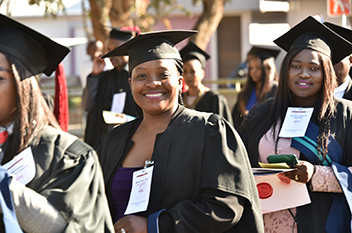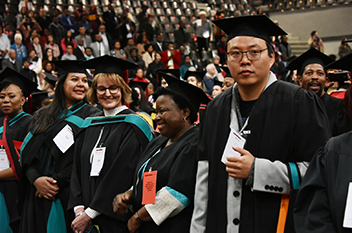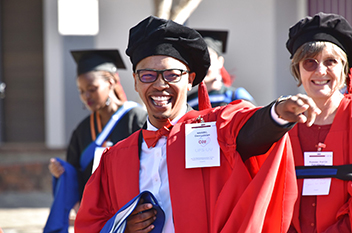View photo gallery at the bottom of the page.
The University of the Free State (UFS) has awarded 474 South Campus Open Distance Learning certificates, 472 master’s, and 95 doctoral degrees to graduates in the Faculties of Economic and Management Sciences, Education, the Humanities, Law, Theology and Religion, Health, and Natural and Agricultural Sciences, during the 2019 June graduation ceremonies.
According to the former Minister of Finance, Chairperson of the Old Mutual Group Holdings, and guest speaker during the ceremonies, Dr Trevor Manuel, “South Africa is a young nation; we need to believe that the best years are ahead of us and let this kind of thinking inform the choices we make.”
The UFS Rector and Vice-Chancellor, Prof Francis Petersen, enthused graduates with ideas to better prepare them for the world of work. One of these ideas was to manifest critical enquiry. “Search for more, search for the truth, challenge the norm and do not just accept everything,” said Prof Petersen.
Kovsies confer three honorary doctorates during June graduation ceremonies
Co-chair of the BRICS (Brazil, Russia, India, China and South Africa) Working Group on Information and Communication Technologies and High-Performance Computing, member of the Advisory Committee of the Breakthrough Listen project, and the former director of the SKA, Dr Bernie Fanaroff, was also honoured with an honorary doctorate from the UFS Faculty of Natural and Agricultural Sciences during the June graduation ceremonies.
UFS Chancellor, Dr Khotso Mokhele, congratulated Fanaroff and commended him for his immeasurable contribution to the global scientific community.
Two other giants – one in the arts and another in law – were honoured at one of the morning graduation ceremonies during the University of the Free State Bloemfontein Campus June graduations. The internationally renowned, award-winning film and theatre artist, Jerry Mofokeng wa Makhetha, received an Honorary Doctor of Letters (DLitt) degree during the ceremony. Sharing the stage with Makhetha was Madam Justice Mahube Molemela, who received an Honorary Doctor of Laws (LLD) degree. Justice Molemela is the first female Judge President of the Free State division of the High Court.
One of the many highlights during the June graduation ceremonies was when eight researchers from the International Studies Group received their doctoral degrees (PhDs).
Dr Trevor Manuel further referred to the National Development Plan and the values enshrined in the South African Constitution, urging graduates to carry the country forward. “Each and every career is contributing to the transformation of society," he said.
Graduands told they are ‘persons of value’ in education sector
Former Free Stater and Chairperson of the GivenGain Foundation, Advocate Frans Stroebel, also addressed UFS graduates as an esteemed guest speaker for the various ceremonies. Adv Stroebel explained to graduating teachers that they are ‘people of value’, and as such, give much more than what they take. He praised them, saying: “I thank you now, in advance, for the role that you are going to play in the lives of our children in the next ten years.”
He further spoke on the theme of ‘Choices’, highlighting the fact that each choice results in someone having to take responsibility for something.
For information about upcoming UFS graduation ceremonies, visit the UFS graduation ceremonies page.
Bloemfontein Campus:
WATCH: 27 June 2019 Ceremony(Afternoon Session)
 14:30:
14:30: South Campus
Advanced certificates and Professional diplomas
Graduation Programme
“You have the responsibility of teaching a young generation that is waiting for your guidance and mentorship.” - Adv Frans Stroebel
WATCH: 28 June 2019(Morning Session)

8:30: Faculties of Economic and Management Sciences, Education, the Humanities, Law and Theology and Religion
Master's and doctoral qualifications
Graduation Programme
WATCH: 28 June 2019 (Afternoon Session) 13:30:
13:30: Faculties of Health Sciences and Natural and Agricultural Sciences
Master's and doctoral qualifications
Graduation Programme